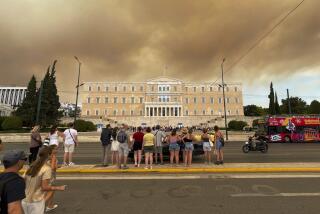On a Clear Day . . . : You Must Not Be in Athens
- Share via
ATHENS — The government says its campaign to reduce atmospheric pollution is working, but some among Athens’ 3.5 million people are not so sure.
For years, the capital has been plagued by a brown layer of noxious smoke, exhaust fumes and factory emissions that Athenians call the nefos, Greek for cloud.
On a warm, windless day, the nefos sends an average of 300 Athenians to hospitals complaining of headaches, chest pains, nausea and stinging eyes.
“I drive around Athens all day, and when I get home my nose is clogged and my hair is oily from the fumes,” said Michalis Leontsakos, one of the city’s 15,000 taxi drivers. “And when summer hits, it’s much worse.”
Last July a 10-day heat wave compounded the smog problem, and more than 1,200 mostly poor and elderly Athenians died of heatstroke or breathing problems.
Officials in Prime Minister Andreas Papandreou’s Socialist government maintain, however, that a new package of anti-smog measures is producing results and that last summer’s high temperatures are unlikely to recur.
“The recent package has been particularly productive,” Environment Minister Evangelos Kouloumbis said. “We have had a 15% to 25% reduction in overall pollution levels.”
The smog forms over the mountain-ringed Athens basin on warm, still days.
The sun heats up a layer of cold night air close to the ground and the air then rises into the lower atmosphere, where it acts as a barrier that traps the warmer pollutants under it.
The problem is aggravated by the lack of parks and green spaces in Athens’ concrete sprawl. The city has just 23 square feet of greenery per resident, contrasted with 107 square feet in Rome, 215 in Vienna and 290 in Amsterdam.
Environmental scientists blame the city’s 750,000 cars, diesel-powered taxis, buses and trucks for 75% of the smog.
“If you take away half the cars, you’d only have half the problem,” said Dimitris Hadzidakis, a chemical engineer with the state-run pollution-control program. “Traffic would move faster and you’d have few engines idling.”
To cut down on traffic the government abolished Greece’s traditional split working day with its three-hour midday break. Stores now stay open from 9 a.m. to 7 p.m., and the change eliminated two of the city’s four rush hours.
The new measures also ban half the city’s taxis from the five-square-mile city center on alternate days and have closed a two-square-mile central commercial district to traffic.
But despite the government claims, some people who work in the city center say they can’t see much improvement.
“The nefos seems to be the same, and fewer people shop in the afternoon hours because of the heat and smog,” said Michalis Vitos, a shoe store clerk. “The summer looks like it’s going to be worse and will definitely cut business.”
Half of the city’s private cars have been banned from the center on alternate days since 1984. Cars with license plates ending in even numbers drive on even-numbered days and vice versa.
“We think that updated cars burning unleaded gasoline must gradually replace Athens’ current fleet of private automobiles,” Kouloumbis said.
But Greeks complain they can’t afford to buy new cars because of import taxes that triple the basic price. Transportation Ministry statistics indicate the average private car in Athens is 10 years old.
The government’s 1985 target of a 27% pollution reduction by 1990 is still on track, but it may take 20 more years to fully solve the problem, environment officials say.
“The trouble is the city’s spreading faster than we can reduce the pollution and there are 30,000 more cars on the streets every year,” said Hadzidakis.
The government has banned low-quality heating fuel and insists that filters be installed on Athens’ 120 main industrial plants by the end of this year.
But independent environmental researchers say the measures still aren’t enough.
“To solve the pollution problem, you’d have to remove all industry from Athens and find some way to make at least 1 million Athenians move at least 30 kilometers (19 miles) out of the city,” said Panayiotis Christodoulakis, president of the Panhellenic Center for Ecological Studies.
More to Read
Sign up for Essential California
The most important California stories and recommendations in your inbox every morning.
You may occasionally receive promotional content from the Los Angeles Times.













